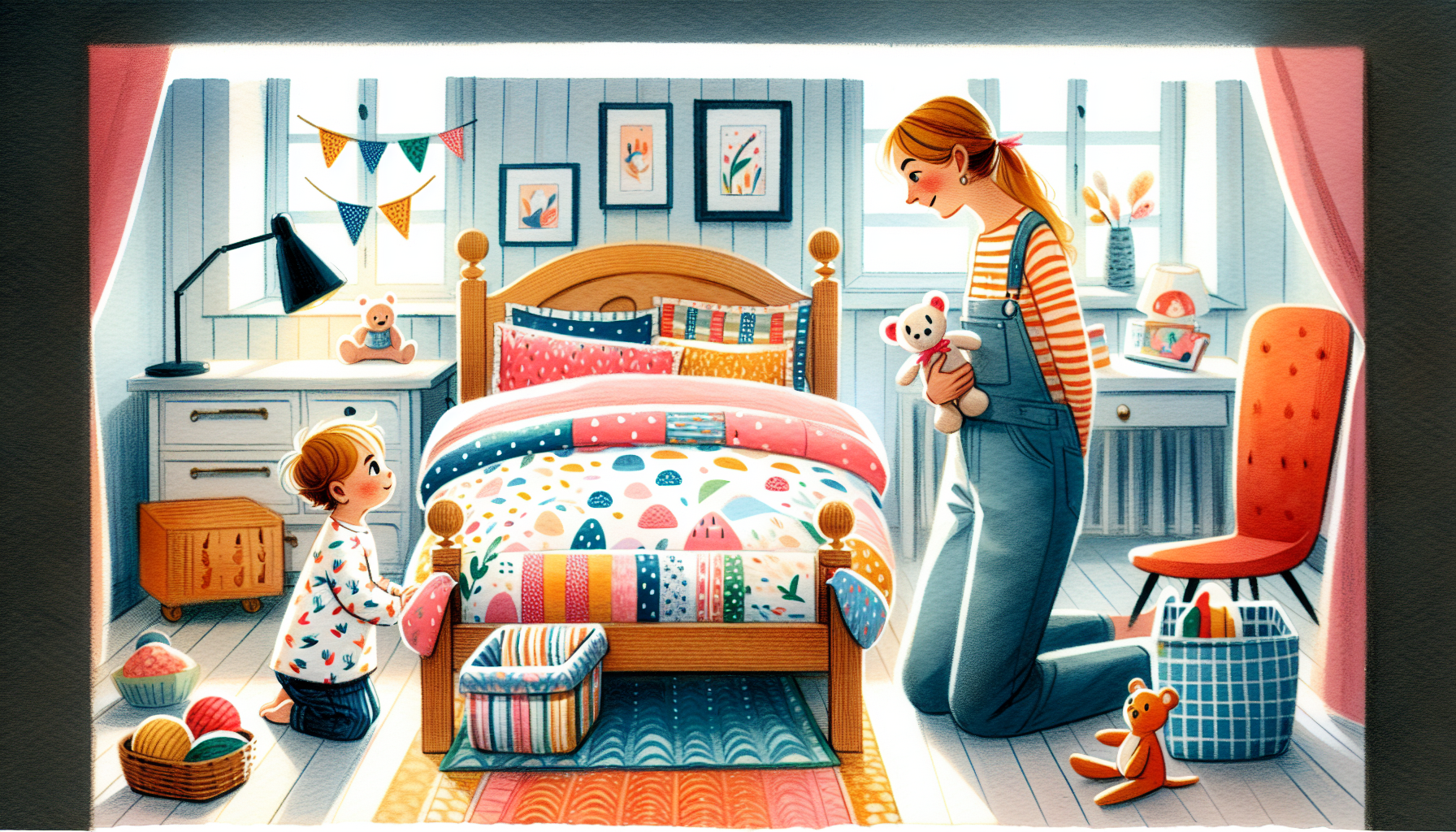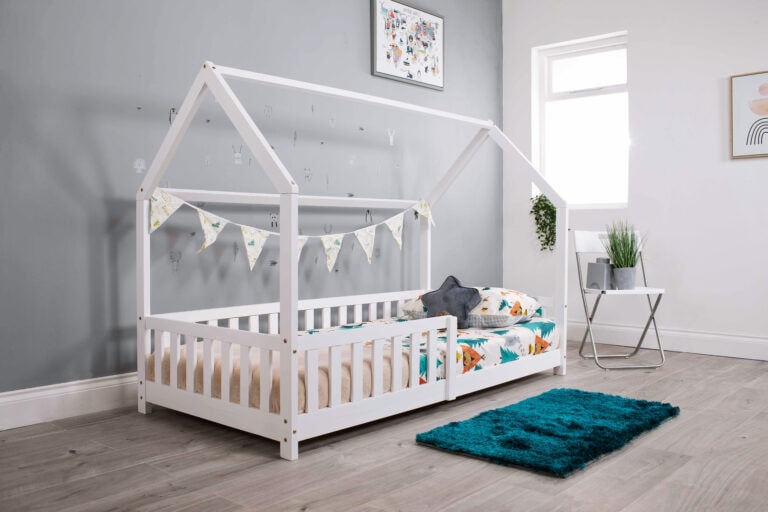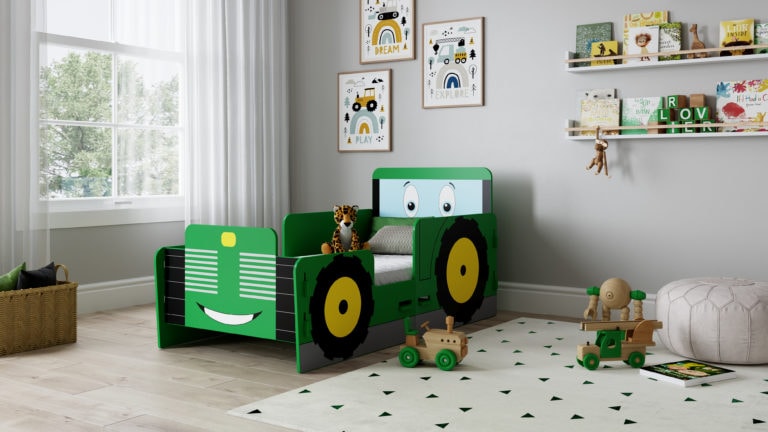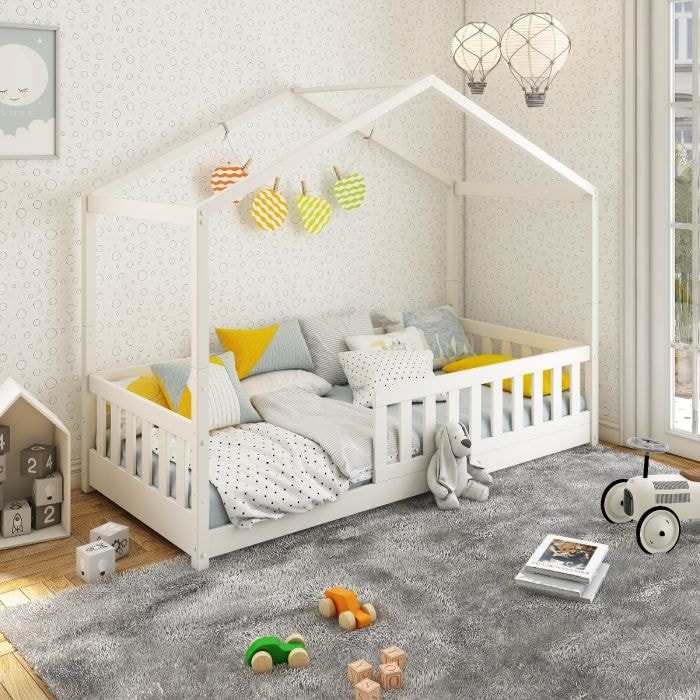Blog
What Age Should a Child Sleep in Their Own Bed? Expert Tips and Guidelines
Wondering at what age should a child sleep in their own bed? Most children transition between 18 months and 3 years old. In this guide, we’ll discuss the signs of readiness, age guidelines, and tips for a smooth change.
Key Takeaways
- Children typically transition from a cot to their own bed between 18 months and 3 years, with signs of readiness including climbing out of their crib and expressing interest in a ‘big kid’ bed.
- Choosing the right bed involves prioritising safety features, such as guardrails and appropriate height while considering the child’s growth needs with options like a toddler bed, a starter/shorty bed, or a fun, themed bed.
- Establishing a consistent bedtime routine and involving the child in the transition process can facilitate a smoother move to their own bed, making it a more positive experience.
Signs Your Child is Ready for Their Own Bed
Recognising when your child is ready to transition to their own bed helps ensure a smooth move. One of the first indicators is developmental readiness. A child who can follow simple instructions and routines has likely reached the independence needed for this change. If your child starts insisting on choosing their own clothes or toys, it indicates they are ready to take on more responsibility, including sleeping in a ‘big bed’.
Outgrowing their crib or attempting to climb out are clear signs that the cot bars are no longer suitable. This not only poses a safety risk but also suggests that they need more space to move and grow.
Expressing interest in sleeping in a ‘big kid’ bed is a good indication of mental preparedness for the transition to their very own bed.
Collectively, these signs indicate readiness to move from a cot to a bed. Acting upon these cues at the right time can make the transition smoother and more enjoyable for both you and your child.

Age Guidelines for Transitioning to Their Own Bed
The transition from a cot to a toddler bed typically occurs between 18 months and 3 years old. Many children show readiness for a bed around the age of 2 to 4 years, with some starting the process between 18 months and 2 years old. This age range reflects individual differences in development and readiness.
Height can also be a factor. Children should ideally be around 3 feet tall to safely transition from a crib, ensuring they can get in and out of bed without difficulty. Consistent nighttime potty training is another useful indicator that it may be time to transition to a bed. However, it’s important not to rush this process. Delaying the transition if your child is still learning self-control can prevent unnecessary stress and challenges.
The goal is to make the bed transition at a pace that suits your child’s individual needs and development. Waiting until clear signs of readiness appear can help ensure a successful and smooth move from cot to bed.

Pictured: Explorer White Playhouse Bed
Choosing the Right Bed for Your Child
Choosing the right bed for your child involves considering several options. Toddler beds, single beds, and convertible beds offer unique benefits. Toddler beds are popular for their safety features, including raised sides to prevent falls and being low to the ground for easy access. Many toddler beds can also be converted into larger beds as your child grows, providing longevity and value for money.
Single beds, particularly suitable for children aged 4 and older, provide more space and can accommodate growth. Convertible beds offer versatility, adapting to various age stages from toddler to older child, which can be beneficial for future transitions.
Safety features should be a priority. Toddler beds often include guardrails to mimic the secure feeling of a crib and prevent rolling out of bed. If choosing a single or convertible bed, adding bed rails can enhance safety.
Choose a bed frame that allows room for growth and a firm cot mattress that fits snugly within the frame for comfort and safety. Carefully considering these factors will help you select a bed that meets your child’s current needs while accommodating future growth and development.
Preparing Your Child’s Bedroom
Creating a safe and comfortable sleep environment is crucial when preparing your child’s bedroom for the new bed. Perform a thorough safety check to eliminate potential hazards. Childproofing the room prevents nighttime accidents. A baby gate at the bedroom door can limit access and ensure your child stays within a safe area. If the bedroom is on a different floor, install a baby gate at the top of the stairs as well.
Comfort features can make the bedroom more inviting. Place a soft mattress or padding on the floor near the bed to cushion falls. Introducing a mattress on the floor initially can provide a secure sleeping environment during the transition. Night lights create a cosy atmosphere and can alleviate fears of the dark.
Keep the area around the bed clear of furniture or large toys to prevent tripping hazards and ensure a safer sleep environment. Taking these steps creates a bedroom that is both safe and conducive to a good night’s sleep.

Pictured: Kidsaw Tractor Junior Toddler Bed
Establishing a Bedtime Routine
A well-established bedtime routine helps your child fall asleep easily and enjoy a restful night. Bedtime routines reinforce sleep signals and improve sleep quality, making them integral to the transition from cot to bed. Consistency helps children feel secure and reduces confusion, which can lead to bedtime anxiety.
A bedtime routine should include calming activities that signal it’s time to wind down. Brushing teeth, changing into pyjamas, and reading a bedtime story effectively establish a nightly bedtime routine. These activities prepare your child physically for sleep and provide familiarity and comfort.
Visual cues like toddler clocks can enhance the bedtime routine. These clocks signal bedtime and reinforce the nightly routine. Consistent bedtime routines make the transition to a new bed easier and more enjoyable for your child.

Ensuring a Smooth Transition
A smooth transition from cot to bed requires patience and strategic steps. Here are some suggestions to help with the process:
- Introduce the new bed gradually, beginning with short sleep periods like naptime.
- Transition to nighttime sleep only after your child is comfortable with the new bed.
- Use a gradual approach to help your child get used to the new sleeping arrangement without feeling overwhelmed.
By following these steps, you can make the transition smoother for your child.
Reward systems like stickers or verbal encouragement can celebrate successful nights in the new bed and motivate continued progress. Separation anxiety can arise during this transition; offering reassurance and comfort helps ease this challenge.
Patience and consistency are key. Each child adjusts at their own pace, and a calm, supportive environment helps them feel secure and confident in their new bed. Following these tips ensures a successful transition for your little one.
Handling Nighttime Challenges
Nighttime challenges are common during the transition from cot to bed but can be managed effectively with the right strategies. For persistent night-time awakenings, a reward system like a bedtime pass can encourage your child to stay in bed. Parents should maintain a calm demeanour and avoid making a fuss when their child repeatedly gets out of bed.
If your child climbs out of bed, gently take their hand and lead them back, reassuring them with phrases like, ‘It’s time to go to bed – see you in the morning.’ You may need to return your child to bed several times, but positive reinforcement can help.
If your child continuously leaves bed, it may be beneficial to revisit the cot for a while before attempting the transition again. Monitoring your child’s response and making necessary adjustments can effectively manage nighttime challenges.

Pictured: Froya Evolutionary Single White Bed
Involving Your Child in the Process
Involving your child in the transition process can foster excitement and make the change more enjoyable. One way to do this is by letting them choose their bed and bedding. Shopping for these items can enhance excitement about the transition and give them a sense of ownership.
Witnessing the conversion of their cot into a bed can help your child understand the transition better. Involving them in decorating their new room can make the transition more enjoyable and acceptable. Engaging your child in these activities helps them feel more involved, comfortable, and secure in their new sleeping arrangement.
These steps help your child feel more at ease with the transition and create a positive experience for the whole family.
Safety Considerations
Safety during the transition from cot to bed is paramount. Secure furniture to prevent tipping when your child climbs on it. Anchor bookcases and other heavy furniture to the walls to prevent accidents. Install safety locks on windows to limit how far they can be opened, and secure cords for curtains and blinds out of reach.
Keep electrical appliances out of the bedroom and use outlet covers to protect your child from accessing electrical outlets. Place pillows or a soft mattress on the floor beside the bed to cushion falls.
A night light can alleviate fears of the dark and create a comforting sleep environment. Following these safety considerations ensures a secure sleep environment, making the transition to a new bed both comfortable and safe.
Summary
Transitioning your child from a cot to their own bed is a significant step in their development. Recognizing the signs of readiness, choosing the right bed, preparing the bedroom, and establishing a consistent bedtime routine are all crucial elements of a successful transition. By involving your child in the process and addressing any nighttime challenges with patience and consistency, you can make this transition smoother and more enjoyable for everyone.
Remember, every child is unique, and the timing and approach to this transition may vary. Trust your instincts and seek professional advice if needed. With the right preparation and support, your child will soon be enjoying a restful night in their very own bed.
Ready to start the transition? Pick out the perfect bed by diving into our full range of children’s beds.
Frequently Asked Questions
What is the recommended age to transition from a cot to a toddler bed?
The recommended age to transition from a cot to a toddler bed is typically between 2 to 3 years, coinciding with the child’s increased mobility. This shift ensures their safety and comfort as they grow.
What safety features do toddler beds have?
Toddler beds are designed with safety in mind, typically featuring guardrails and a low height to minimise the risk of falls. These elements are essential for ensuring a secure sleep environment for young children.
What should be considered when choosing a mattress for a toddler bed?
When choosing a mattress for a toddler bed, prioritize a firm mattress that fits snugly within the bed frame to ensure both safety and comfort.
What are the benefits of toddler beds?
Toddler beds offer safety features and are designed close to the ground for easy access, making them a practical choice as your child transitions from a crib. Furthermore, they can accommodate the child’s growth, ensuring long-term use.



